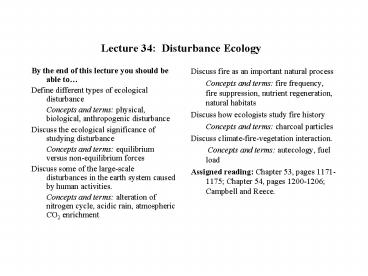Lecture 34: Disturbance Ecology - PowerPoint PPT Presentation
1 / 22
Title:
Lecture 34: Disturbance Ecology
Description:
Define different types of ecological disturbance ... Marine communities are subject to disturbance by tropical storms. Karr, 1985 ... – PowerPoint PPT presentation
Number of Views:1445
Avg rating:3.0/5.0
Title: Lecture 34: Disturbance Ecology
1
Lecture 34 Disturbance Ecology
- By the end of this lecture you should be able to
- Define different types of ecological disturbance
- Concepts and terms physical, biological,
anthropogenic disturbance - Discuss the ecological significance of studying
disturbance - Concepts and terms equilibrium versus
non-equilibrium forces - Discuss some of the large-scale disturbances in
the earth system caused by human activities. - Concepts and terms alteration of nitrogen
cycle, acidic rain, atmospheric CO2 enrichment
- Discuss fire as an important natural process
- Concepts and terms fire frequency, fire
suppression, nutrient regeneration, natural
habitats - Discuss how ecologists study fire history
- Concepts and terms charcoal particles
- Discuss climate-fire-vegetation interaction.
- Concepts and terms autecology, fuel load
- Assigned reading Chapter 53, pages 1171-1175
Chapter 54, pages 1200-1206 Campbell and Reece.
2
- Disturbances are events like fire, weather, or
human activities that can alter communities. - Some are routine.
3
- Marine communities are subject to disturbance by
tropical storms.
4
Anthropogenic disturbance
Karr, 1985
5
(No Transcript)
6
Equilibrium vs. Nonequilibrium Forces
Influencing Community Structure
Equilibrium stability, climax community -Competi
tion -Predation -Other species
interactions Nonequilibrium communities
constantly changing -Disturbances -Recruitment
7
- Highest species diversity is found at
intermediate level of disturbance - High disturbance leads to death of species
- Low disturbance limits species through dominance
and competition
8
Humans are the most widespread agents of
disturbance
- Human activities cause more disturbance than
natural events and usually reduce species
diversity in communities.
9
- In agricultural ecosystems, a large amount of
nutrients are removed from the area in the crop
biomass. - After awhile, the natural store of nutrients can
become exhausted.
10
Combustion of fossil fuels is the main cause of
acid precipitation
11
(No Transcript)
12
http//www.nps.gov/yell/nature/fire/
13
(No Transcript)
14
Andrea Hui Former IB150 student James Scholar
Current MD student at UIC
15
1 Hypotheses Ho Forest fire occurs more
frequently when climate is warmer and
drier. H1 Forest fire does not occur more
frequently when climate is warmer and drier.
16
2. Research methods
Paleoecology
- Charcoal, pollen
17
(No Transcript)
18
3. Results
Macroscopic charcoal (gt180 ?m)
19
(No Transcript)
20
(No Transcript)
21
autecology
22
- 4 Conclusion
- Ecological traits of dominant species are
- as important as or more important than climate
- for fire occurrence.
- 5 Questions (critical thinking)!!
- Is this conclusion applicable to plant
communities - in other regions?
- Is it applicable to future conditions?

